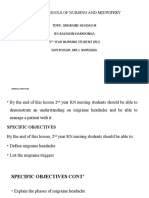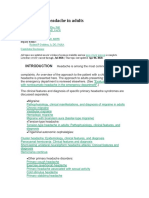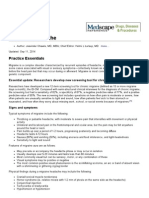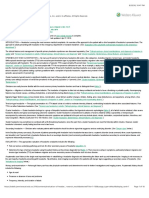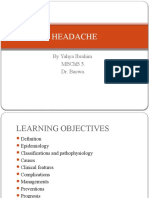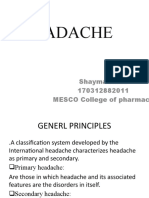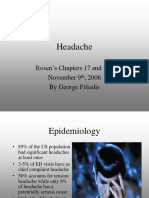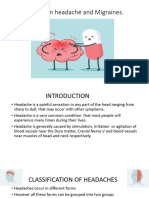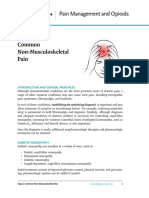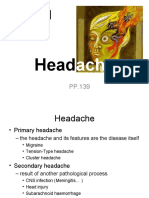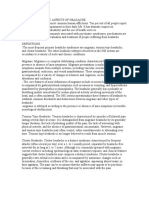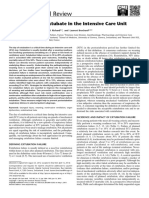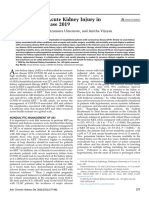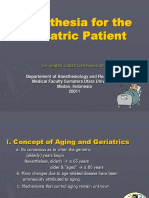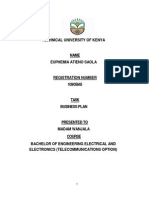2 Migraine
2 Migraine
Uploaded by
Tommy ArisandyCopyright:
Available Formats
2 Migraine
2 Migraine
Uploaded by
Tommy ArisandyCopyright
Available Formats
Share this document
Did you find this document useful?
Is this content inappropriate?
Copyright:
Available Formats
2 Migraine
2 Migraine
Uploaded by
Tommy ArisandyCopyright:
Available Formats
Migraine
Clinical Picture
What Symptoms Occur During a Migraine Attack?
Migraineurs have recurrent, severe, and disabling attacks of headache, often unilateral and pulsating, along with
symptoms of sensory disturbance, such as light, sound, and odor sensitivity. Nausea and neck stiffness are other
common symptoms, and symptoms can be aggravated by movement.
Some patients experience dizziness during attacks.
About 2030% of patients experience aura and neurological symptoms (e.g., visual disturbances), which usually
precede the headache phase of an attack.
Premonitory symptoms such as yawning, irritability, tiredness, cravings, and difficulty concentrating sometimes
precede headache onset.
What Is Migraine Aura, and What Symptoms Can Occur?
An aura is any neurological symptom that occurs shortly before the headache attack. Visual symptoms (e.g., flickering
lights or zigzag phenomena), somatosensory symptoms (e.g., paresthesias), speech problems, and rarely, motor
symptoms can occur during aura.
Symptoms usually last >5 and <60 minutes.
Before migraine can be diagnosed, other possible neurological deficits must first be excluded.
Cortical spreading depression (see below) is thought to be the pathophysiological cause.
What Can Trigger a Migraine?
Menstruation
Shortness of sleep, irregular sleep, or too much sleep
Stress (or in some patients, relaxation from stress)
Alcohol (e.g., red wine)
Caffeine (e.g., coffee, chocolate)
Foods containing glutamate or aspartame
Dehydration
Vasodilating drugs (e.g., nitrates)
Epidemiology
How Many People Are Affected by Migraine?
Women: about 1318% of the population
Men: about 510% of the population
Numbers may be lower in Asian populations
Chronic Migraine
About 4% of the adult population experiences chronic headache, i.e., headache on 15 or more days a month. About half
of this group has chronic migraine, and the other half has chronic tension-type headache [7].
Disorders/Abnormalities That Can Be Comorbid with Migraine
Anxiety
Depression
Fibromyalgia
Back pain
Hypertension
Stroke and cardiac disease
Childhood vomiting
Pathophysiology
Migraine Pathophysiology
Migraine was considered to be vascular in origin for much of the 20th century [6], but today it is considered to be a
disorder of the brain, with abnormalities in the vasculature occurring secondary to the primary neuronal events. Migraine
has a strong inherited component, and a large genetic study suggests the involvement of glutamate pathways in migraine
pathogenesis [1]. Genetic variations on chromosome 19 have been reported for rare forms of familial hemiplegic migraine
(FHM1 and 2).
Migraine Aura Pathophysiology
Cortical spreading depression (CSD), a process transiently compromising cortical function at a speed of about 3 mm per
minute [5] is thought to be the underlying mechanism of aura [2]. It is possible that CSD is also implicated in the
generation of migraine headache.
Definition/Diagnosis/Differential Diagnosis
The International Classification of Headache Disorders
Distinguishes primary headache syndromes from secondary, symptomatic headache diseases. Migraine and tension-
type headache are the most common types of primary headache. The classification of primary headache disorders is
based on a phenomenological (operational) categorization. In contrast, secondary headaches, which have to be ruled
out, are classified according to their etiology (e.g., headache attributed to a tumor or a vascular abnormality). Some
types of migraine can be classified based on genetic markers (familial hemiplegic migraine).
Defines episodic migraine as migraine attacks occurring on fewer than 15 days a month and chronic migraine as
attacks occurring on 15 or more days a month.
Other potential causes of headache such as intracranial/spinal pathology, musculoskeletal pathology,
inflammatory/autoimmune diseases, systemic illnesses, or drug-related headaches have to be ruled out by clinical
history, neurological examination, and additional diagnostic tests, when appropriate, in order to diagnose migraine.
Migraine: Diagnostic Criteria (ICHD-2) [4] Without Aura
A. At least 5 attacks fulfilling criteria B-D
B. Headache attacks lasting 472 hours (untreated or unsuccessfully treated)
C. Headache has at least 2 of the following characteristics:
unilateral location
pulsating quality
moderate or severe pain intensity
aggravation by or causing avoidance of routine physical activity (e.g., walking or climbing stairs)
D. During headache at least 1 of the following:
nausea and/or vomiting
photophobia and phonophobia
E. Not attributed to another disorder
Therapy
How Can Migraine Attacks Be Treated?
Simple analgesics (e.g., aspirin, acetaminophen/paracetamol)
NSAIDs (e.g., naproxen, ibuprofen, diclofenac)
Triptans (e.g., sumatriptan)
Second choice treatment: ergot derivatives (e.g., dihydroergotamine)
In the future, CGRP-receptor antagonists such as telcagepant may be a new option for the treatment of acute attacks
[3].
Compound analgesics, such as those containing aspirin, acetaminophen/paracetamol, and caffeine have been shown
to be more effective than single analgesics. However, they are thought to increase the risk of medication overuse
headache (see below).
What to Do When Nausea Is an Issue
Antiemetics/prokinetics, such as domperidone or metoclopramide, can improve nausea.
These medications are sometimes given before the analgesics to improve absorption of the medication.
Preventive Pharmacological Therapy in Episodic Migraine
Preventive therapy is suitable for patients with frequent and/or severe, disabling attacks.
A large number of different medications with differing mechanisms of action have been tested in randomized placebo-
controlled trials and are available for treatment. Propranolol, topiramate, valproate, flunarizine, and amitriptyline are
examples of medications that are frequently used and have proven efficacy [3].
On average, a 50% decrease in headache frequency can be expected for half the patients using one preventive
medication.
Preventive Pharmacological Therapy in Chronic Migraine
Best scientific evidence exists for use of topiramate or Botulinum toxin injections for pharmacological prevention of
chronic migraine.
Specialist treatment is useful in patients with chronic migraine or refractory migraine.
Medication Overuse
Is defined as consumption of triptans, ergotamine, opioids, or combination analgesics on 10 days or more per month,
or simple analgesics on 15 days or more a month.
Is an important issue in migraine therapy and needs to be identified and managed.
Can produce rebound headache.
Can reduce the efficacy of preventive therapy.
Can mask the headache phenotype.
Nonpharmacological Management of Migraine
Patient education
Identify and avoid triggers
Maintain regular daily activities
Maintain a regular sleep/wake cycle
Aerobic exercise
Consider weight reduction in overweight patients
Biofeedback
Acupuncture
Relaxation techniques
Cognitive-behavioral therapy
There is currently no evidence supporting homeopathy for migraine treatment
There is no convincing evidence regarding efficacy of closure of patent foramen ovale (PFO) for migraine treatment.
PFO closure should not be performed outside of clinical trials.
Migraine surgery, such as surgical cauterization of the superficial blood vessels of the scalp or the removal of
muscles or nerves thought to be trigger sites, is advocated by some plastic surgeons, but there is poor scientific
evidence and no convincing rationale to support this measure. Migraine surgery is currently not recommended
outside of clinical trials.
Neuromodulation Approaches
The efficacy of migraine therapy using electrostimulation of peripheral nerves is currently being investigated in studies
(see the fact sheet on Neuromodulation in Primary Headaches). Results are pending.
References
[1] Anttila V, Stefansson H, Kallela M, et al. Genome-wide association study of migraine implicates a common susceptibility variant on
8q22.1. Nat Genet 2010;42:86973.
[2] Dalkara T, Nozari A, Moskowitz MA. Migraine aura pathophysiology: the role of blood vessels and microembolisation. Lancet
Neurol 2010;9:30917.
[3] Goadsby PJ, Sprenger T. Current practice and future directions in the prevention and acute management of migraine. Lancet
Neurol 2010;9:28598.
[4] Headache Classification Subcommittee of the International Headache Society. The International Classification of Headache
Disorders, 2nd edition. Cephalalgia 2004;24(Suppl 1):9160.
[5] Lashley K. Patterns of cerebral integration indicated by the scotomas of migraine. Arch Neurol Psychiatry 1941;46:3319.
[6] Moskowitz MA, Buzzi MG, Sakas DE, Linnik MD. Pain mechanisms underlying vascular headaches: progress report 1989. Rev
Neurol (Paris) 1989;145:18193.
[7] Scher AI, Stewart WF, Lipton RB. Epidemiology of chronic daily headache. In: Goadsby PJ, Silbersten SD, Dodick DW, editors.
Chronic daily headache for clinicians. Ontario: BC Decker; 2005. p. 311.
Copyright 2011 International Association for the Study of Pain
You might also like
- MIGRAINEDocument34 pagesMIGRAINEBaldwin Hamzcorp HamoongaNo ratings yet
- Emcee Script JsDocument10 pagesEmcee Script JsRon Styx88% (24)
- Headache 2Document21 pagesHeadache 2geeeelzy07No ratings yet
- Evaluation of Headache in AdultsDocument19 pagesEvaluation of Headache in AdultsBeatriz SilvaNo ratings yet
- CEFALEA Evaluation of Headache in Adults - UpToDateDocument23 pagesCEFALEA Evaluation of Headache in Adults - UpToDateJOSE ANTONIO ALBARRAN MENDOZANo ratings yet
- Headache Brunner and Suddarth Ed 12Document6 pagesHeadache Brunner and Suddarth Ed 12jaberfaithbayanganNo ratings yet
- Head Ache and Head InjuryDocument84 pagesHead Ache and Head InjuryDeepika LingamNo ratings yet
- Migraine Headache PDFDocument14 pagesMigraine Headache PDFAl Hasyr SarminNo ratings yet
- Evaluation of Headache in Adults - UpToDateDocument18 pagesEvaluation of Headache in Adults - UpToDateSebastianNo ratings yet
- MigraineDocument16 pagesMigraineBheru LalNo ratings yet
- What Is A Migraine Headache?Document18 pagesWhat Is A Migraine Headache?mrsarojnayak8840No ratings yet
- Cefaleas 2018Document87 pagesCefaleas 2018Anonimo DesconocidoNo ratings yet
- CCJM Relieving Migraine PainDocument12 pagesCCJM Relieving Migraine PainBrian HarrisNo ratings yet
- Migraine Headaches - University of Maryland Medical Center PDFDocument22 pagesMigraine Headaches - University of Maryland Medical Center PDFAl Hasyr SarminNo ratings yet
- MOTASEMDocument5 pagesMOTASEMmustafasammy244No ratings yet
- Migraine and TypesDocument28 pagesMigraine and TypesQindeel FatimaNo ratings yet
- Headache and SeizuresDocument30 pagesHeadache and Seizurestawfekmohamed03No ratings yet
- Daily StarDocument3 pagesDaily Staridno1008No ratings yet
- Headache: by Yahya Ibrahim MBCHB 3. Dr. BacwaDocument54 pagesHeadache: by Yahya Ibrahim MBCHB 3. Dr. BacwaHarun MohamedNo ratings yet
- MigrainesDocument6 pagesMigrainesGennie_Hamilto_7821No ratings yet
- Activity 56 Headache Zillah QuizolDocument6 pagesActivity 56 Headache Zillah QuizolARAGON GEMMA LYNNo ratings yet
- S7 - Nervous SystemDocument22 pagesS7 - Nervous Systemyouservezeropurpose113No ratings yet
- Management of Migraine Headache: An Overview of Current PracticeDocument7 pagesManagement of Migraine Headache: An Overview of Current Practicelili yatiNo ratings yet
- 2 Migraine SerbianDocument3 pages2 Migraine SerbianRose GoldNo ratings yet
- CephalgiaDocument30 pagesCephalgiaMurdani MurdaniasihNo ratings yet
- Headache NewDocument17 pagesHeadache NewHaris PeaceNo ratings yet
- Evaluation of Headache in AdultsDocument21 pagesEvaluation of Headache in AdultsMaicon RamosNo ratings yet
- Medicine 1Document32 pagesMedicine 1semenyadaviourNo ratings yet
- SDL 21 Headaches BMS16091064Document8 pagesSDL 21 Headaches BMS16091064Jonathan YeohNo ratings yet
- Share On Facebook Share On Twitter: Cerebral HypoxiaDocument7 pagesShare On Facebook Share On Twitter: Cerebral HypoxiaBilog Ang MundoNo ratings yet
- HeadacheDocument24 pagesHeadacheshayma khanNo ratings yet
- Headaches 5Document26 pagesHeadaches 5Elvis obajeNo ratings yet
- Pemicu 6 Blok Saraf Dan KejiwaanDocument44 pagesPemicu 6 Blok Saraf Dan KejiwaanTommy WidjajaNo ratings yet
- A Headache Is Defined As A Pain in The Head or Upper Neck.: Migraine HeadachesDocument5 pagesA Headache Is Defined As A Pain in The Head or Upper Neck.: Migraine HeadachesGhada WageihNo ratings yet
- Headache: Rosen's Chapters 17 and 105 November 9, 2006 by George FiliadisDocument45 pagesHeadache: Rosen's Chapters 17 and 105 November 9, 2006 by George Filiadisradiologi igdNo ratings yet
- MigraineDocument9 pagesMigraineRose Athena SibalaNo ratings yet
- HeadacheDocument36 pagesHeadacheabenezer g/kirstosNo ratings yet
- HEADACHEDocument7 pagesHEADACHEHiba MohammedNo ratings yet
- Headache & Migraine DrugsDocument59 pagesHeadache & Migraine Drugsjoshua katunziNo ratings yet
- Tension Type HeadacheDocument30 pagesTension Type HeadacheIndraYudhi100% (2)
- Topic 2 Common Non Musculoskeletal PainDocument4 pagesTopic 2 Common Non Musculoskeletal PainDavid Dominguez RomeroNo ratings yet
- HeadacheDocument41 pagesHeadacheNatalia Khan100% (1)
- 4 HeadacheDocument67 pages4 HeadacheyekunoNo ratings yet
- MigraineDocument30 pagesMigraineFathimathNo ratings yet
- Module II 1 - EpilepsyDocument38 pagesModule II 1 - Epilepsyaysha jasimNo ratings yet
- 4 HeadacheDocument77 pages4 HeadacheBeki MekuNo ratings yet
- 4 HeadacheDocument33 pages4 HeadacheNathaniel BudayNo ratings yet
- 4.migrain HeadacheDocument20 pages4.migrain HeadacheBensonNo ratings yet
- Conquering Headaches and Migraines: A Comprehensive Guide to Relief and PreventionFrom EverandConquering Headaches and Migraines: A Comprehensive Guide to Relief and PreventionNo ratings yet
- Cluster HeadacheDocument2 pagesCluster HeadachenanikNo ratings yet
- 11 Types of Headaches - Causes, Symptoms, and TreatmentDocument27 pages11 Types of Headaches - Causes, Symptoms, and TreatmentCHIMA ONWUKA MONGNo ratings yet
- 1 Neuropsychiatry of HeadacheDocument6 pages1 Neuropsychiatry of HeadachepriyadikkalaNo ratings yet
- Clinph (2) HeadacheDocument14 pagesClinph (2) HeadacheLagmayDy, LexterNo ratings yet
- A Migraine Headache PresentationDocument14 pagesA Migraine Headache PresentationAbdullah Masud TanjimNo ratings yet
- Care of The Client With Altered Intracranial Functioning: Headaches Seizures Meningitis/EncephalitisDocument33 pagesCare of The Client With Altered Intracranial Functioning: Headaches Seizures Meningitis/Encephalitisdcline18No ratings yet
- Drugs For Treatment of Migraine and Vertigo: Dharma Permana, Apt, PHDDocument27 pagesDrugs For Treatment of Migraine and Vertigo: Dharma Permana, Apt, PHDZera DirgantaraNo ratings yet
- Ukdi Preparation I:: Neurogenic Pain Syndromes Peripheral Nerve DisordersDocument65 pagesUkdi Preparation I:: Neurogenic Pain Syndromes Peripheral Nerve DisordersFelicia SutarliNo ratings yet
- By: Negesse T. (M.SC, N) : Management of Patient With Neurologic DysfunctionDocument53 pagesBy: Negesse T. (M.SC, N) : Management of Patient With Neurologic DysfunctionErsido SamuelNo ratings yet
- Neurology EmergenciesDocument78 pagesNeurology Emergenciesmrbalwa419No ratings yet
- Migraine Headaches: PubertyDocument14 pagesMigraine Headaches: Pubertyswitgil28No ratings yet
- KDIGO Sees Updating Guidelines As High PriorityDocument4 pagesKDIGO Sees Updating Guidelines As High PriorityTommy ArisandyNo ratings yet
- Diuretics When and HowDocument34 pagesDiuretics When and HowTommy ArisandyNo ratings yet
- rccm.201208 1523ci 2 PDFDocument9 pagesrccm.201208 1523ci 2 PDFTommy ArisandyNo ratings yet
- Management of Acute Kidney Injury in Coronavirus Disease 2019Document6 pagesManagement of Acute Kidney Injury in Coronavirus Disease 2019Tommy ArisandyNo ratings yet
- Anesthesia For GeriatricDocument23 pagesAnesthesia For GeriatricTommy ArisandyNo ratings yet
- Jadwal Dokter RS Sentra Medika Cikarang NewwDocument1 pageJadwal Dokter RS Sentra Medika Cikarang NewwTommy Arisandy100% (1)
- Cancer Pain Management Implications For Psychologists Stacy OgbeideDocument19 pagesCancer Pain Management Implications For Psychologists Stacy OgbeideTommy ArisandyNo ratings yet
- Intravenous Sub-Anesthetic Ketamine For Perioperative AnalgesiaDocument8 pagesIntravenous Sub-Anesthetic Ketamine For Perioperative AnalgesiaTommy ArisandyNo ratings yet
- Harvest MoonDocument42 pagesHarvest MoonTommy ArisandyNo ratings yet
- Energi Pada Kontraksi JantungDocument21 pagesEnergi Pada Kontraksi JantungTommy ArisandyNo ratings yet
- Audi LogDocument1 pageAudi LogTommy ArisandyNo ratings yet
- Analisis Kuantitatif Sediaan Obat DGN SpektrofluorometriDocument71 pagesAnalisis Kuantitatif Sediaan Obat DGN SpektrofluorometrideeNo ratings yet
- MATH 8 Lesson Plan CODocument3 pagesMATH 8 Lesson Plan COSerdnelem Rhodz MacedaNo ratings yet
- IEEE Transactions Power Apparatus and Systems, Vol. PAS-100, No. 2, February 1981Document8 pagesIEEE Transactions Power Apparatus and Systems, Vol. PAS-100, No. 2, February 1981Kevin Alexander Becerra SulcaNo ratings yet
- Australia and New ZealandDocument6 pagesAustralia and New Zealandbrunocz2No ratings yet
- UNIT 02 TV Activity WorksheetsDocument3 pagesUNIT 02 TV Activity WorksheetsTriệu HảiNo ratings yet
- Mission Green Sept 2017Document1 pageMission Green Sept 2017Robert OkandaNo ratings yet
- Pertaining To RhythmDocument12 pagesPertaining To RhythmRODALYN M. SOLISNo ratings yet
- Business PlanDocument36 pagesBusiness PlanArun NarayananNo ratings yet
- Dabur IndiaDocument24 pagesDabur IndiaSauabh Srivastava100% (2)
- Enraf 682 Manual EnglishDocument106 pagesEnraf 682 Manual EnglishMintflex PhysiotherapyNo ratings yet
- (Iii) "Class C Fire" - Fire Arising Out of Gaseous SubstancesDocument2 pages(Iii) "Class C Fire" - Fire Arising Out of Gaseous SubstancestulasiraoNo ratings yet
- PhysicsDocument2 pagesPhysicsSuyash DixitNo ratings yet
- Amniotic Fluid Sludge Is Associated With Earlier Preterm Delivery and Raised Cervicovaginal Interleukin 8 ConcentrationsDocument7 pagesAmniotic Fluid Sludge Is Associated With Earlier Preterm Delivery and Raised Cervicovaginal Interleukin 8 ConcentrationsShinta Dewi WulandariNo ratings yet
- 2017 SP The Killing of A Sacred Deer Final ScriptDocument102 pages2017 SP The Killing of A Sacred Deer Final ScriptjasonbkohlNo ratings yet
- Cisco Networking Interview QuestionsDocument8 pagesCisco Networking Interview Questionsajit8279No ratings yet
- Spencer Green Pathways PlannerDocument2 pagesSpencer Green Pathways PlannerspencerxgreenNo ratings yet
- Dwight v. Swain - Techniques of The Selling Writer 12Document4 pagesDwight v. Swain - Techniques of The Selling Writer 12lucasgioNo ratings yet
- CDATA-XPON ONU - (C+ BOSA) - FD511G-X-F690 (1GE) Datasheet-V3.0Document4 pagesCDATA-XPON ONU - (C+ BOSA) - FD511G-X-F690 (1GE) Datasheet-V3.0fabi1988lindaNo ratings yet
- VITAMINSDocument31 pagesVITAMINSjeshemaNo ratings yet
- Physics Experiment Report (Iv) Basic Physics "Oscillation Mathematics"Document8 pagesPhysics Experiment Report (Iv) Basic Physics "Oscillation Mathematics"JkanthNo ratings yet
- Doing Good and Making Change - Chronicle Issue 4Document10 pagesDoing Good and Making Change - Chronicle Issue 4SpecialtyCoffeeNo ratings yet
- Acute PancreatitisDocument2 pagesAcute PancreatitisLanh TangcongNo ratings yet
- Eagle Syndrome An Unusual Cause of Head and Neck PainDocument2 pagesEagle Syndrome An Unusual Cause of Head and Neck PainCecilia AnderssonNo ratings yet
- Chapter 25Document8 pagesChapter 25Clar Aaron BautistaNo ratings yet
- Technical and Operating Instructions Manual Along With Cpl/PilDocument13 pagesTechnical and Operating Instructions Manual Along With Cpl/PilCidhin NairNo ratings yet
- Information Sheet 1.2-3: Driver/Device DriverDocument9 pagesInformation Sheet 1.2-3: Driver/Device DriverDenver Dennis BalilingNo ratings yet
- Tennis Leg Gastrocnemius Injury Is A Far More Comm-1Document4 pagesTennis Leg Gastrocnemius Injury Is A Far More Comm-1jasonoytumandukNo ratings yet
- RCD AssignmentDocument3 pagesRCD AssignmentArj AsisNo ratings yet
- Machine Profiles: D10R Track-Type TractorsDocument5 pagesMachine Profiles: D10R Track-Type TractorsJavier Pagan TorresNo ratings yet
